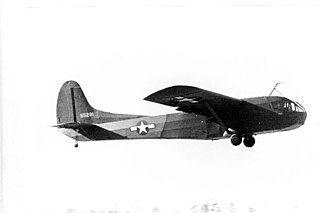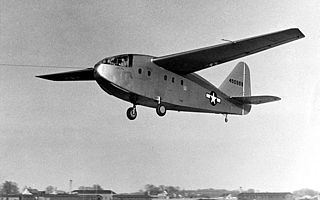Operators
 Australia
Australia
- Royal Australian Air Force
- School of Land and Air Warfare [1]
| DHA-G2 | |
|---|---|
| Role | Transport glider |
| National origin | Australia |
| Manufacturer | de Havilland Australia |
| First flight | 1942 |
| Introduction | 1942 |
| Retired | 1952 |
| Primary user | Royal Australian Air Force |
| Number built | 2 DHA-G1 6 DHA-G2 |
The de Havilland Australia DHA-G2 was a Second World War Australian transport glider based on the earlier prototype DHA-G1. [1] Only two prototype G1 and six production G2 gliders were built. [2]
The G1 glider was designed to meet a Royal Australian Air Force (RAAF) requirement for a transport glider to specification 5/42. [1] Two prototype gliders, sometimes known as Experimental Glider 1, were ordered from de Havilland Australia (DHA). [1] [2] As DHA were already committed to build Tiger Moth basic trainers and Dragon navigation trainers, most of the work was to be done by subcontractors, with much of the build work on the two prototypes being carried out on the fifth floor of a Mill in Camperdown, Sydney. [3] It was a high-wing cantilever monoplane of all wooden construction, making extensive use of plywood. It used the cockpit canopy of the DH.84 Dragon, but was otherwise an original design. The aircraft's undercarriage used a single mainwheel behind a long nose skid, and a wooden tailskid. The crew consisted of a single pilot with seats for six passengers. [4]
The first prototype made its maiden flight on 14 June 1942, and was accepted by the RAAF on 11 October 1942, with the second prototype following on 17 November. [5] A production order was placed with DHA for a modified version, but with the threat of invasion less likely, as well as the availability of Douglas Dakota transports and Waco Hadrian gliders from the United States, only six were ordered. [2] [6] The G2 was of similar layout to the G1, but had a slightly larger fuselage and a shorter span wing that could be broken into three parts to aid transportation. The first production G2 flew on 20 March 1943 and was delivered to the RAAF on 6 May 1943, with the remaining 5 following in July that year. They saw little use, with most of the gliders being stored, with the first G2 being used for glider conversion training. [7] The surviving gliders were reduced to components in 1952. [2]
The first G2, serial number A57-1, was modified in 1948 by the Government Aircraft Factory for trials of a suction airfoil, the modifications included the fitting of a 96 hp (72 kW) Mercury 95A engine. Trials continued until 1951. [2] [8]
Data from , [2] Air International July 1976, [5] Jane's all the World's Aircraft 1947 [9]
General characteristics
Performance

The Pilatus PC-9 is a single-engine, low-wing tandem-seat turboprop training aircraft manufactured by Pilatus Aircraft of Switzerland. Designed as a more powerful evolution of the Pilatus PC-7, the PC-9's first flight was made in May 1984 after which certification was achieved in September 1985. After this, the first production orders for the type were received from the Royal Saudi Air Force, with deliveries commencing in 1985. Since then, more than 250 airframes have been produced across five different variants and the type is employed by a number of military and civilian operators around the world, including the Swiss Air Force, the Croatian Air Force, and the Royal Thai Air Force.

The Pacific Aerospace Corporation CT/4 Airtrainer series is an all-metal-construction, single-engine, two-place with side-by-side seating, fully aerobatic, piston-engined, basic training aircraft manufactured in Hamilton, New Zealand.

The Hawker P.1081, also known as the "Australian Fighter" was a prototype British jet aircraft from the mid-twentieth century. The single example built was destroyed in a crash in 1951.

The SZD-45 Ogar (Hound) is a T-tailed cantilever high-wing monoplane of wooden, aluminium and fibreglass construction designed and manufactured in Poland.

The de Havilland Australia DHA-3 Drover is a small transport aircraft that was built by de Havilland Australia (DHA) in the 1940s and 1950s. The aircraft had some similarities with the two-engine British-built de Havilland Dove but used a trimotor configuration.

The de Havilland DH.94 Moth Minor was a 1930s British two-seat tourer/trainer aircraft built by de Havilland at Hatfield Aerodrome, England. With the start of the second world war production of the Moth Minor was moved to de Havilland Australia at Bankstown Aerodrome, Australia.

The Foster Wikner Wicko was a 1930s British two-seat cabin monoplane built by the Foster Wikner Aircraft Company Limited at Southampton Airport, Hampshire.

The Waco CG-15 was an American military glider, which was developed from the CG-4. Although outwardly similar to its predecessor and carrying the same number of passengers, a number of changes in the design, including shortened wings and a more streamlined nose enabled it to travel faster. 1,000 were ordered and 473 were delivered before production ceased. Two were transferred to the Navy for testing as the XLR2W-1. One unit was converted into an XPG-3 powered glider which used two Jacobs R-755-9 radial engines.

The DFS 331 was a transport glider prototype developed in a collaboration between DFS and Gotha. It was a twenty-seat troop transport designed by Hans Jacobs, who had previously produced the successful, nine seat DFS 230.

The PZL-5 was a Polish two-seat touring and sports aircraft of 1930 constructed and produced by the PZL.

The Mudry CAP 10 is a two-seat training aerobatic aircraft first built in 1970 and still in production in 2007. The plane was developed from the Piel Super Emeraude and was born as the CP100. The name changed to CAP 10, CAP for 'Constructions Aéronautiques Parisiennes'. The CAP 10 was manufactured by Mudry in Bernay, France, bought by CAP Industries which then became Apex Aircraft. Following the bankruptcy of Apex in 2008, rights to produce spares were awarded to Dyn'Aviation. After the bankruptcy of DynAero in 2012, manufacture of spares was taken over by CEAPR in Darois.

The Miles M.4A Merlin was a 1930s British five-seat cabin monoplane built by Miles Aircraft Limited.

The Elliotts of Newbury EoN or Elliotts EoN A.P.4 was a 1940s British four-seat touring monoplane aircraft built by Elliotts of Newbury.
The AAC Wamira was a turboprop military trainer aircraft, designed for the Royal Australian Air Force (RAAF) by the Australian Aircraft Consortium (AAC). The project was cancelled shortly before the first prototype was completed.

The Waco CG-13 was an American military transport glider aircraft developed during World War II.

The Slingsby T.49 Capstan is a British two-seat glider of the 1960s built by Slingsby Sailplanes as a replacement for their earlier Type 42 Eagle. It is a high-winged monoplane of wooden construction, the last two-seat wooden glider built by Slingsby, intended for both training and general club flying. Side-by-side seats for the two pilots are accommodated in an enclosed cockpit with a one-piece perspex canopy. The prototype T.49A first flew in 1961, and it entered production as the T.49B in 1963. Thirty-four Capstans were built, one of which was fitted with an auxiliary engine with the designation T.49C Powered Capstan.
The SZD-25A Lis was a single-seat glider aircraft that was designed and built in Poland from 1955, derived from the SZD-16 Gil and SZD-25 Nov.

The Scheibe Bergfalke is a German glider designed by Egon Scheibe as a post-World War II development of the Akaflieg München Mü13 produced before and during the war.

The Chase CG-14, also known as the G-14 or Model MS.1, was an assault glider manufactured by Chase Aircraft for the United States Army Air Forces during the Second World War. The aircraft failed to progress beyond the prototype stage, being overtaken by larger, improved glider designs.
The Hindustan Aircraft G-1 was a Second World War Indian transport glider, the first design of Hindustan Aircraft Limited, only one glider was built.
| Wikimedia Commons has media related to De Havilland Australia . |